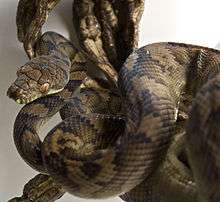Tracy M. Barker
Tracy Jo Barker (née Miller) (born December 10, 1957)[1] is an American herpetologist specialized in pythons.
Barker grew up in Washington, D.C., as the daughter of J. Jefferson Miller[2][3] who was Curator of ceramics and glass at the Smithsonian Institution.[4] After an undergraduate degree in psychology at the University of Colorado,[5] she graduated in biology at the Central Michigan University.[6] Beside, she worked as a reptile keeper at Buffalo Zoological Gardens.[4][7] Already in her early years, she specialized in herpetology and focused on animal behavior. She worked as a field biologist for repopulating Green Iguanas in Panama[8][9] and studied the reproductive behavior of Tuatara on Stephens Island in New Zealand.[10][4]

In 1990 she and her husband, biologist David G. Barker, founded Vida Preciosa International, Inc [VPI], an enterprise dedicated to the research necessary to establish self-sustaining captive populations of pythons and boas. This facility became one of the largest and most diverse collection of pythons in the world; in 1997, the Barkers and their work at VPI were featured in a National Geographic Television documentary titled “Passion for Pythons”.[4][11][12] They managed to reproduce 32 of the 52 recognized taxa of pythons. Among them, the first ever reproduction of 12 taxa.[13]
Barker has written numerous papers in scientific journals as well as dozens of popular publications. In 1979, Barker described a new species of python Python saxuloides, which is currently regarded as a slightly distinct Kenyan population of the later re-erected Python natalensis.[14][15] One of her five books, Pythons of the World, Volume 2: Ball Pythons, was certified as “The Best Animal Book of 2006” by the Independent Publisher Book Awards.[16]
In 2000 a new species of python, Morelia tracyae, was named in her honor.[17]
Books
- Pythons of the World, Volume 3: The Pythons of Asia and the Malay Archipelago. with David G. Barker and Mark Auliya. VPI Library, Boerne, Texas, 2018. 371 pp.
- The Invisible Ark – In Defense of Captivity. with David G. Barker. VPI Library, Boerne, Texas, 2014. 169 pp.
- Pythons of the World, Volume 2: Ball Pythons: The History, Natural History, Care and Breeding. with David G. Barker. VPI Library, Boerne, Texas, 2006. 321pp.
- Pythons of the World, Volume 1, Australia. with David G. Barker. The Herpetocultural Library, Advanced Vivarium Systems, Lakeside, California, 1994. 171 pp.
- The Ball Python Manual. with Philippe de Vosjoli, Roger Klingenberg and David G. Barker. The Herpetocultural Library, Advanced Vivarium Systems, Lakeside, California, 1994. 76 pp.
References
- J. S. Applegarth: Index of Taxonomic Herpetology, Second Edition. IN: Kraig Adler [ed]. Contributions to the History of Herpetology. Society for the Study of Amphibians and Reptiles, 2007, p 164.
- J. Jefferson II Miller, Lyle M. Stone: Eighteenth-Century Ceramics from Fort Michilimackinac. Smithsonian Studies in History and Technology, Washington DC: Smithsonian Institution Press, U. S. Government Press. 1970. https://repository.si.edu/bitstream/handle/10088/2401/SSHT-0004_Lo_res.pdf?sequence=2&isAllowed=y
- J. Kelly: J. Jefferson Miller II, 80, historian. The Baltimore Sun, September 27, 2005. http://articles.baltimoresun.com/2005-09-27/news/0509270078_1_maryland-historical-society-miller-museum-of-history
- T. M. Barker: Written Testimony regarding the Anti-Animal Proposal HR-669, April 23, 2009. http://vpi.com/sites/default/files/HR669_testimony_09_001_4.pdf
- L. Golan, C. Radcliffe, T. Miller, B. O’Connell, D. Chiszar. Trailing Behavior in Prairie Rattlesnakes (Crotalus viridis). Journal of Herpetology, 16, No 3, 1982, p 284-293
- T. J. Miller: Knotting: A previously undescribed feeding behavior in muraenid eels. Copeia (4) 1987, p 1055-1057
- T. Miller: First-Time Reproduction of the Red Eyed Tree Frog. Buffalo Zoo Journal, No 1, 1982
- B. Webster: Inguanas Successfully Bred. The New York Times, September 4, 1984. https://www.nytimes.com/1984/09/04/science/iguanas-successfully-bred.html
- T. J. Miller: Artificial Incubation of Eggs of the Green Iguana (Iguana iguana). Zoo Biology 6, 1987, p 225-236
- J. C. Gillingham, T. J. Miller: Reproductive etology of the Tuatara (Sphenodon punctatus): applications in captive breeding. International Zoo Yearbook, 1991, 30, pp 157-164
- H. B. Lilywhite: How Snakes Work: Structure, Function and Behavior of the World’s Snakes, 2014, p 137.
- IMDb account for Passion for Pythons. National Geographic Explorer. Episode aired 15 September 1997: https://www.imdb.com/title/tt2338384/
- Information on pages 3-4 in: D. G. Barker, T. M. Barker: The Invisible Ark – In Defense of Captivity. VPI Library, Boerne, Texas, 2014.
- T. J. Miller, H. M. Smith: The Lesser African Rock Python. Bulletin of the Maryland Herpetological Society 15, 3, 1979, p 70–84.
- D. G. Broadley: A review of geographical variation in the African Python, Python sebae (Gemelin). British Journal of Herpetology 6, 1984, p 359–367.
- Independent Publisher. Judging Results in 65 National Categories. http://www.independentpublisher.com/article.php?page=1157
- M. B. Harvey, D. G. Barker, L. K. Ammerman, P. T. Chippindale (2000): Systematics of Pythons of the Morelia amethistina Complex (Serpentes: Boidae) with the Description of three new Species. Herpetological Monographs 14, p 139-185.